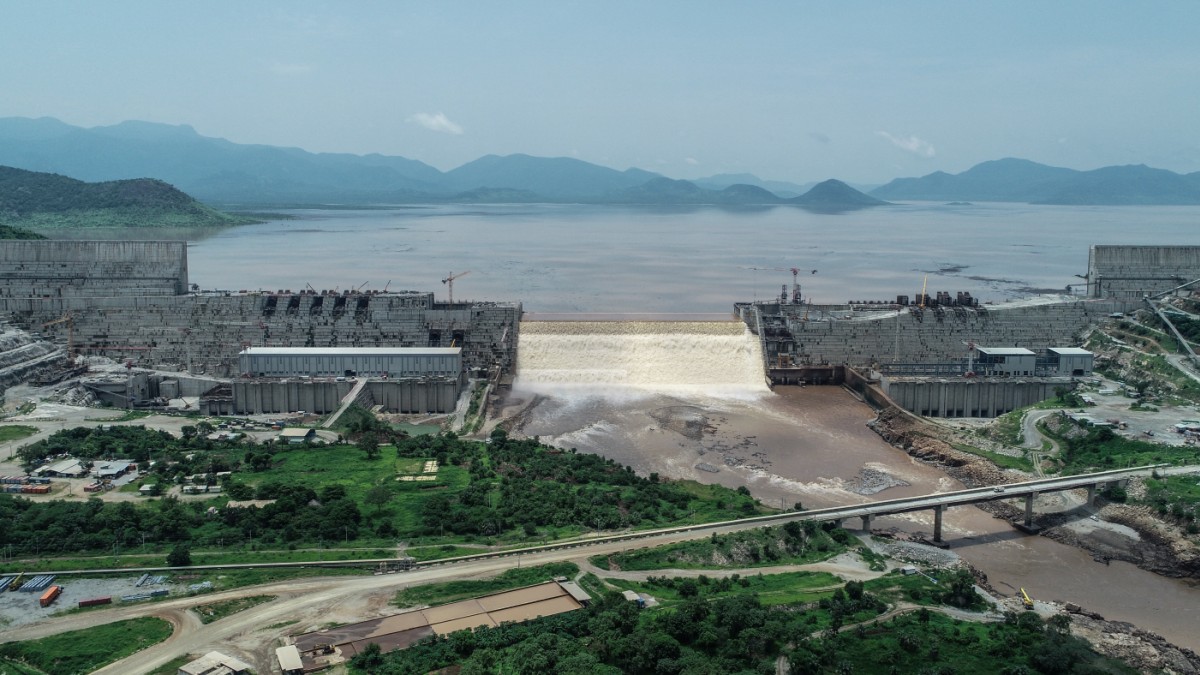Every July it starts to rain in the highlands of Ethiopia, where the Blue Nile rises. The current then swells to five times its normal capacity. But the neighbors on the middle and lower reaches of the Nile, Sudan and above all Egypt, fear that they will not get much from the life-giving water masses. The Ethiopian government announced to Cairo earlier this week that it would continue to fill the reservoir at the Grand Ethiopian Renaissance Dam.
Ethiopia began doing this in the 2020 rainy season. But now the up to 145 meter high dam is closer to completion and could hold back more water. Almost 85 percent of the water flows through the Blue Nile during the three rainy months. In good years it can be 100 billion cubic meters, in a drought it can only be 30 billion. How much is dammed this time depends on the amount of rain, according to Addis Ababa.
Egypt, which for lack of other sources has to cover more than 95 percent of its water consumption from the Nile, protested vehemently. The project is categorically rejected and viewed as a “threat to regional stability,” said Water Minister Mohammed Abdel Aty. Egypt has been calling for a binding contract for years to regulate the filling of the reservoir and the operation of the dam and secure Cairo’s water rights.
In 1959, Egypt signed an agreement on this with Sudan. It assumes that the Nile carries 84 billion cubic meters of water per year. Sudan is allowed to divert 18.5 billion cubic meters, 55.5 billion cubic meters go to Egypt, and that is no longer enough today. Ten billion evaporate and seep away. Ethiopia was not even involved. It therefore rejected the agreement as a colonial legacy and began building the dam. Above all, it should bring electricity to the 100 million country – 6,000 megawatts, as much as six nuclear power plants. And thus enable the development of the economy.
Egypt’s foreign minister warns of “dangerous escalation”
Negotiations took place for years, international experts and mediators were called in, most recently the US administration of ex-President Donald Trump. Without tangible results. Now Egypt’s President Abdel Fattah al-Sisi is intervening in the UN Security Council with the backing of the Arab states. He should discuss the dispute this Thursday. For days, Egypt’s Foreign Minister Sameh Schukri has been courting allies in New York.
He paid homage to the UN ambassadors of China and Russia, as well as their colleagues from the other veto powers France, Great Britain and the USA. Before leaving Cairo, Schukri spoke of a “dangerous escalation on the part of Ethiopia”, and on the East River he is now promoting a “fair and balanced solution”. The Security Council had to live up to its responsibilities and restart negotiations.
France’s Ambassador to the UN, Nicolas de Rivière, who held the rotating chairmanship of the Security Council in July, said there was not much the panel could do other than hear the concerns of everyone involved and urge them to work together. A spokesman for UN Secretary General António Guterres said it was important that “no unilateral actions are taken that would undermine any search for solutions”. Both statements will have been received with relief in Cairo.
The handling of the water dispute in the Security Council could, however, have a precedent character: There are also cross-border river systems in other regions, especially in the Middle East and Asia, on which hundreds of millions of people depend for their water supply, without any agreements on its use among the neighboring states and water quotas there. Population growth and climate change are exacerbating the widespread water shortage, as is the case in Egypt. This quickly gives rise to existential problems with far-reaching implications for international peace and security – safeguarding them is the task of the Security Council.
Ethiopia’s ambassador in Khartoum said Sudan and Egypt are familiar with plans for the rainy season. The topic does not belong on the Security Council. Ethiopia is now pressing for mediation from the African Union, which it had previously refused. The country’s leadership sees the dam as an essential element of the national development strategy. It stands for the longed-for upswing in Ethiopia, as the rulers before Prime Minister Abiy Ahmed already conjured it up.
Bombing is considered a last resort
Former Prime Minister Meles Zenawi said in 2011 the Süddeutsche Zeitung: “Nobody can stop us from using our resources for development. Not even Egypt.” At the same time, he rated the risk of a military conflict as low at the time. This is exactly what Cairo has repeatedly threatened to do, at least indirectly. Bombing the dam is a last resort – but it would cause greater damage with every meter the water rises.
The deepening of the crisis around the Nile coincides with severe upheavals in Ethiopia, in which ethnic groups are increasingly calling for independence. Prime Minister Abiy Ahmed must fight for the unity of the country and its reform course. He tried to reintegrate the breakaway region of Tigray with a war, but in the end the rebels achieved military success and the army withdrew. Abiy’s attempt to secure a strong mandate through elections has also failed.
In view of the symbolic meaning of the dam, he could be tempted to instrumentalize the construction and also the filling more in order to collect the quarreling Ethiopians behind the prestigious national structure. With this, however, the dam is increasingly stylized as the pride of the country, and the danger grows that Ethiopia will become even more inaccessible for discussions because it fears that it will lose face.
.
Kingston is an accomplished author and journalist, known for his in-depth and engaging writing on sports. He currently works as a writer at 247 News Agency, where he has established himself as a respected voice in the sports industry.












